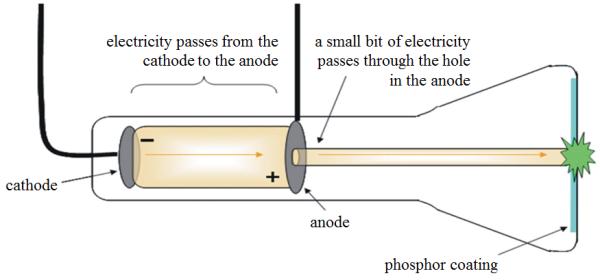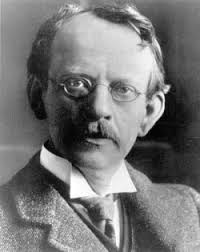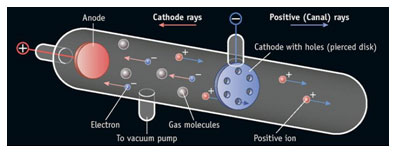J.J. Thomson
by: Ann Johnson
The Main Idea
J. J. Thomson was a Nobel Prize winning English physicist who used cathode rays to discover electrons. He also developed the mass spectrometer.
Biography
J. J. Thomson was born on December 18th, 1856 in England. His father wished he would become an engineer, however he could not find an apprenticeship. He attended Trinity College at Cambridge, and eventually headed the Cavendish Laboratory. Thomson married one of his students, Rose Paget, in 1892. They had two children, Joan and George Thomson. George eventually became a physicist and earned a Nobel Prize of his own. J. J. Thomson published over 200 papers and 13 books. He died on August 30th, 1940 in Cambridge and is buried in Westminster Abbey.
Electron Discovery
J. J. Thomson discovered the electron in 1897 while performing experiments on electric discharge in a high-vacuum cathode ray tube. He interpreted the deflection of the rays by electrically charged plates and magnets as "evidence of bodies much smaller than atoms." He later suggested that the atom is best represented as a sphere of positive matter, through which electrons are positioned by electrostatic forces.
Cathode Ray Experiments
A cathode ray tube is a glass tube with wiring inserted on both ends, and as much air as possible pumped out of it. Cathode rays were discovered to travel in straight lines, just like waves do. Physicists knew that the ray had an electric charge, and they were trying to figure out if that electric charge could be separated from the ray.
Thomson had the hypothesis that the ray and charge were inseparable, and designed experiments using a magnetic field to prove this was true. He first built a cathode ray tube with a metal cylinder at the end. The cylinder had slits in it that were attached to electrometers, that could measure electric charges. When he applied a magnetic field across the tube, no activity was recorded by the electrometers. This meant the charge had been bent away by the magnet. This proved his theory that the charge and the ray were inseparable.
Thomson then worked to proved that the rays had a negative charge. He did this by attempting to deflect them with an electric field by creating a near perfect vacuum, and by using a positive anode and negative cathode to deflect the rays. The rays were deflected by the negative charge, proving that they contained a negative charge.

Isotopes and Mass Spectrometry
After discovering the electron, Thomson started studying positive rays. Positive rays behaved very differently from cathode rays, and he found that each ray followed its own parabolic path based on its detection on the photographic plate. He reasoned that no two particles would follow the same path unless they possessed the same mass-to-charge ratio. He correctly suggested that the positively charged particles were formed by the loss of an electron (isotopes). This created the field of mass spectrometry, which is still used very heavily today.
See also
Properties of matter, including mass and charge, are related to Thomson's work with electrons and the mass spectrometer.
Further reading
Thomson, J. J. (June 1906). "On the Number of Corpuscles in an Atom". Philosophical Magazine 11: 769–781. doi:10.1080/14786440609463496. Archived from the original on 19 December 2007. Retrieved 4 October 2008. Leadership and creativity : a history of the Cavendish Laboratory, 1871 - 1919
External links
https://www.youtube.com/watch?v=WH-U_qCEzT0
http://www.cambridgenetwork.co.uk/news/cambridge-physicist-is-streets-ahead/
References
http://thomson.iqm.unicamp.br/thomson.phphttp://www.chemheritage.org/discover/online-resources/chemistry-in-history/themes/atomic-and-nuclear-structure/thomson.aspx http://www.biography.com/people/jj-thomson-40039 http://study.com/academy/lesson/jj-thomsons-cathode-ray-tube-crt-definition-experiment-diagram.htmlhttps://explorable.com/cathode-ray-experiment
[[Category:Notable Scientists]

